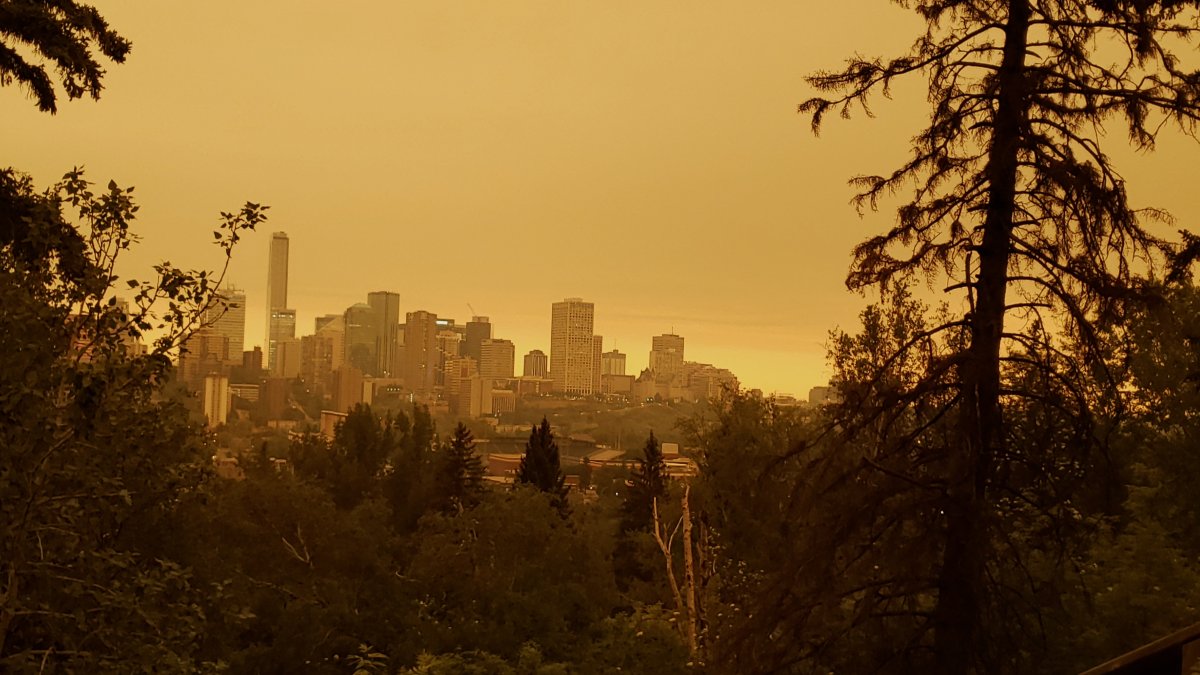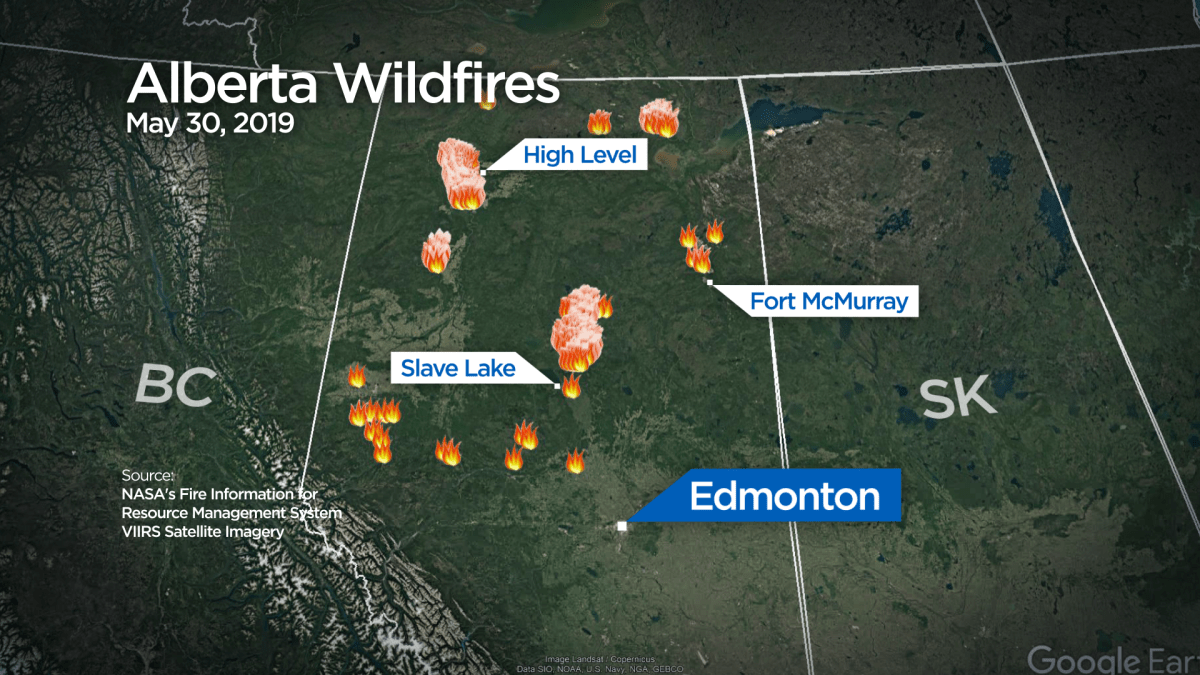People across much of Alberta woke up to grey skies and a strong burning smell in the air as smoke from northern wildfires drifted south overnight.

Environment Canada issued special air quality statements from the Edmonton region to the northern tip of the province.
Areas of central Alberta were also included, including Drayton Valley, Rimbey, Pigeon Lake, Lloydminster, and Wainwright.
By noon Thursday, Environment Canada expanded the special air quality statement to cover almost the entire province, spreading as far south as Medicine Hat, Bow Island and Suffield.
Just before 3 p.m., the statement was expanded to cover other parts of southern Alberta as well, including Calgary.
At around 3:30, the statement stretched all the way to the U.S. border as event the southernmost counties were included.
READ MORE: Smoke from the Alberta wildfires is obscuring the sun in several U.S. cities
As of 5 p.m., the only areas not under the special advisory were an area in the east-central Alberta and the mountain regions to the west.
For a complete list of areas in Alberta that are subject to a weather alert, click here.
A prediction map from FireSmoke.ca indicates the smoke will continue to flow south throughout Thursday.
READ MORE: Smoke fills Calgary skyline from wildfires burning in northern Alberta
Environment Canada said in central parts of the province, smoke is expected to move back north by Friday morning as the flow shifts to southeasterly.
Watch below: The wildfires in northern Alberta impacted Edmontonians on Thursday as smoke created air quality concerns. Kendra Slugoski reports.

Air quality health index
The air quality across northern Alberta is expected to remain high on the Alberta Environment air quality health index (AQHI) all day.
Alberta Health measures the AQHI on a scale of one to 10, with higher numbers meaning a greater health risk.
Most of Alberta, including the Edmonton region, is expected to be at a seven, or “moderate risk,” on Thursday. Some areas to the northwest, including Grande Prairie, are forecast to be higher on the scale.
Most of Alberta, including the Edmonton region, was at a seven, or “moderate risk,” on Thursday.
At about 4:30 p.m., Edmonton hit 10+. The scale doesn’t measure past 10.
Edmonton Catholic Schools’ policy is to keep students indoors at lunch and recess when the air quality health index reaches 7 or higher.

Get daily National news
Spokesperson Lori Nagy said some schools in Edmonton have decided to keep kids inside during recess on Thursday, even though Edmonton’s air quality health index had not yet reached 7.
Nagy said the school district has also cancelled all junior high sports activities that were taking place outside.
Edmonton Public Schools also keeps students indoors, with windows closed, air conditioning and HVAC air systems on days when Environment Canada issues an air quality rating at seven or higher.
“Principals will use this guideline to make the best decisions for the health and safety of their students,” EPS spokeswoman Megan Normandeau said in a statement. “With today’s air quality warning, a number of our schools have decided to have indoor recess.
“This administrative regulation also applies to field trips where students will be outside for an extended period of time. We do know a number of district schools did cancel field trips today due to the poor air quality.”
LISTEN BELOW: How vulnerable is Edmonton to a wildfire?
The Edmonton Minor Soccer Association also follows the Canadian air quality report and cancels games if the air quality reaches a seven.
The league’s president says between 700 and 800 games have been cancelled for Thursday. That’s all the games scheduled for the day.
The Edmonton Eskimos also announced that the team’s practice would be held indoors.
Early Thursday afternoon, the Edmonton Prospects announced the game against the Okotoks Dawgs would go forward as planned at 7 p.m.
For this game only, the team is offering fans the chance to purchase tickets in the shared suites for only $25 for people who may have concerns about the air quality.
Environment Canada said some people may experience increased coughing, throat irritation, headaches or shortness of breath due to the smoke. Children, seniors, and those with cardiovascular or lung disease, such as asthma, are especially at risk.
READ MORE: Climate change report warns of more extreme weather events in Alberta
People with lung diseases, such as asthma and COPD, can be particularly sensitive to air pollution and will generally experience more serious health effects at lower levels. Pollution can aggravate their diseases, leading to increased medication use, doctor and emergency room visits, and hospital visits.
Those with difficulty breathing are advised to stay indoors. Using an air conditioner that cools and filters air may help. The weather agency suggests if your home isn’t air-conditioned, consider going to a public place (library, shopping mall, recreation centre) that is air-conditioned.
Wildfire update
According to Alberta Wildfire, there were 25 active wildfires across the province as of 10 a.m. on Wednesday.
Of those, six had been sparked in the last 24 hours and seven were considered to be out of control. Updated numbers are expected Thursday morning.
READ MORE: Northern Alberta wildfires prompt Kenney government to declare disaster, public emergency
The fires are burning in multiple areas hundreds of kilometres apart, triggering evacuations of several communities in northwestern and north-central Alberta.
- Donald Trump claims B.C.’s ‘very large faucet’ could help California’s water woes
- Canada must speed up progress to hit its 2030 emissions target: report
- U.S. TikTok ban case pits free speech vs. national security. Which will win?
- Meta bans RT, other Russian state media outlets over ‘foreign interference’
Mandatory evacuation orders are in effect for:
- Town of High Level and Mackenzie Country areas south/southeast of town
- Dene Tha’ First Nation communities of Bushe River, Meander River and Chateh
- Paddle Prairie Metis Settlement
- Keg River, Carcajou, and all residents from the northern border of the County of Northern Lights to Township Road 922 (Notikewin Road)
- Wabasca and the Bigstone Cree Nation in the MD of Opportunity
- Chipewyan Lake Village in in the MD of Opportunity
High Level leaders issue statement on evacuation
In the High Level area, about 5,000 people have been out of their homes for more than a week because of a raging fire that won’t stop growing. It stood at 1,500 square kilometres on Wednesday, but crews have managed to keep the flames out of the town.
High Level Mayor Crystal McAteer, Reeve Josh Knelsen of Mackenzie County and Dene Tha’ First Nation Chief James Ahnassay issued a joint statement on Facebook.
“We know that many of you are very anxious to hear about what is happening with the wildfire and the situation in our communities. Many of you have been out of your homes and away from your work for a long time.” they wrote.
The leaders urged patience.
“On Wednesday, the wildfire threatening our communities grew significantly and exhibited extreme and volatile fire behaviour. We simply don’t know for sure what this fire will do next.
“The danger to High Level remains, and the danger to communities in Mackenzie County and the Dene Tha’ First Nation has increased. Four more areas were evacuated … More than 600 of our neighbours had to leave their homes.”
The goal is to get residents of High Level home by the weekend, the post said.
“But with this wildfire we can’t promise anything. For other communities, we know it will be later. Please be patient with us. The situation is constantly changing and there are no firm timelines.”
READ MORE: Northern Alberta MD of Opportunity communities ordered to evacuate overnight due to wildfires
Experts have forecast a summer of high wildfire danger across Western Canada and have warned that climate change will continue to worsen fire seasons in the future.
— With files from The Canadian Press
























Comments